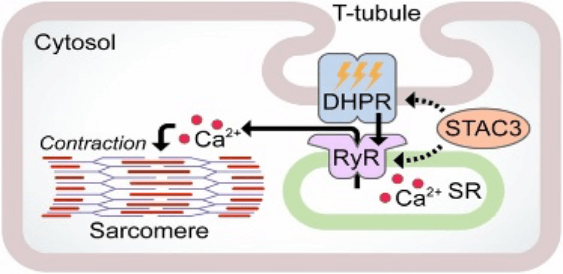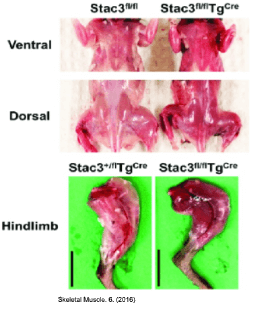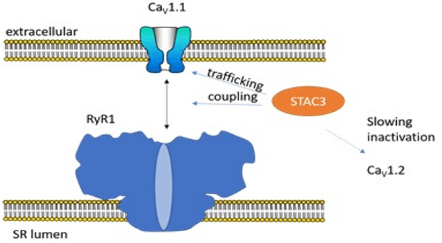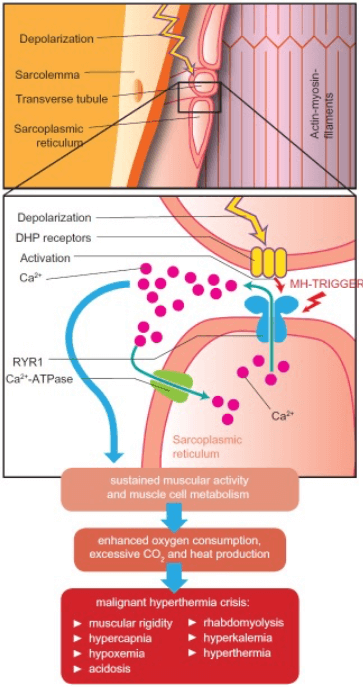Research
Muscle movement and STAC3
The coordinated contraction and relaxation of skeletal muscles is crucial in the proper functioning and movement of the body, and changes in ion concentration in muscle cells are responsible for stimulating these contractions. This process in which chemical signals trigger muscle contraction is called excitation-contraction (E-C) coupling, which is regulated by the conformationally coupled dihydropyridine receptor (DHPR) localized on the plasma membrane and ryanodine receptor 1 (RYR1) located on the membrane of the sarcoplasmic reticulum (SR).
The STAC3 gene encodes a protein which acts as an essential chaperon protein of the Cav1.1 helix, a principle unit of DHPR. STAC3 facilitates the movements of Cav1.1 in response to depolarization of plasma membrane, causing RYR1 to release calcium ions from SR. Ultimately, this increase in intracellular calcium ion concentration triggers muscle contraction and body movement.
PNAS. 2015 Jan 13.

PNAS. 2013 Jul 16.
STAC3 Mutation
The homozygous p.Trp284Ser variant in human STAC3 gene, identified among affected individuals, is responsible for reduced levels and impaired function of the STAC3 protein. Studies have demonstrated that a lack of functioning STAC3 protein inhibits the release of stored calcium ions via RYR1 channels in skeletal muscle. These disruptions in calcium ion release subsequently prevents proper muscle contraction and contributes to symptoms of muscle weakness that are characteristic of STAC3 disorder. Cong et al reported that body musculature of 8-week old STAC3fl/flTgCre (STAC3 knockout) mice appeared to be redder compared to that of STAC3fl/fl (control) mice, indicating that STAC-3 deleted muscles had increased myoglobin content and thus greater slow-twitch type I fibers and fewer fast-twitch type II fibers than control muscles. The altered fiber composition accounts for the decreased limb muscle strength in STAC3fl/flTgCre mice and is consistent with symptoms of hypotonia in NAM patients.
Skeletal Muscle, BMC. 2016 Apr 11.


SLAC National Accelerator Laboratory. 2018 Mar 30.
STAC3 disorder is inherited in an autosomal recessive pattern, as presentation of the condition occurs when an individual possesses mutations in both copies of the gene in each cell. The parents of an individual with STAC3 disorder will carry at least one copy of the mutated gene, but may not present symptoms of the condition themselves.
SLAC National Accelerator Laboratory. 2018 Mar 30.
Hyperthermia
Individuals affected with STAC3 disorder are more susceptible to malignant hyperthermia, in which a severe reaction develops to certain drugs during surgical procedures. Anesthetic drugs that block sensations of pain were shown to induce malignant hyperthermia in individuals with STAC3 disorder, with symptoms including rhabdomyolysis (muscle tissue breakdown resulting in myoglobin release and damaged kidneys), high fever, rapid heart rate, muscle rigidity, and acidosis. A combination of anesthetic drugs and muscle relaxants that are often utilized during surgery can be especially fatal to individuals with STAC3 disorder.
Although the exact mechanisms that correlate STAC3 mutation and malignant hyperthermia remain unclear, it has been established that mutations in other genes can lead to improper activation of the RYR1 channel when certain drugs are used. The overactivation of the RYR1 channel results in excessive release of calcium ions from skeletal muscle cells, leading to abnormal muscle contractions. Further studies are required to elucidate whether STAC3 gene mutations are also responsible for this effect on RYR1 channel activity.
The Journal of Biomedical Research. 2020 Apr 2o.


© 2021 STAC3.org